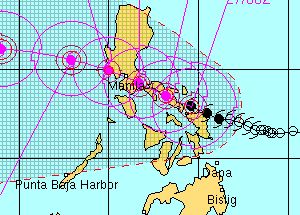 Manila's most powerful typhoon in the last 10 years went by fast and hard, leaving much destruction and debris in its wake. Cars and trucks upturned, roof and concrete walls collapsed, electric posts, trees and those damn billboards falling on electric wires, cars, buildings, houses and people. Those "killer" billboards really have to go.
Manila's most powerful typhoon in the last 10 years went by fast and hard, leaving much destruction and debris in its wake. Cars and trucks upturned, roof and concrete walls collapsed, electric posts, trees and those damn billboards falling on electric wires, cars, buildings, houses and people. Those "killer" billboards really have to go.So far there are 11 dead and 34 missing. Not to mention the damage done to infrastructure.
The morning was relatively peaceful, but winds started picking up by noon. At around 2pm the wind was howling so hard it felt like a horror movie set. There wasn't much rain early on but the 160 kph winds were so fierce our house shook every time a particularly strong gust of wind hit it. I kept looking out, checking on our 20-year old mango tree, I was afraid it would fall over! Electricty went out around 2:15, but mercifully came back on before dark at around 6pm.
 Thankfully my neighborhood survived relatively unscathed save for fallen branches, leaves and the occasional gutter strewn about. The rest of the Metro is in much worse shape. You've got to wonder how much of the damage was completely out of our hands and how much of it could've been prevented.
Thankfully my neighborhood survived relatively unscathed save for fallen branches, leaves and the occasional gutter strewn about. The rest of the Metro is in much worse shape. You've got to wonder how much of the damage was completely out of our hands and how much of it could've been prevented.I hear Mayor Atienza's Manila was hardest hit, being directly along the coast of the bay. But really, I'm in Intramuros 4 times a week and I've personally been on a nightmarish drive home where my 9-year old car doubled as an amphibious vehicle. It took only 30 minutes of strong downpour and the streets all around the Manila city hall were about a feet deep in water. And about 2 feet along the streets near the flower market (near Dangwa transco). On that 90 minute drive home I kept thinking, we live in a country that annually welcomes around 20-30 typhoons. Caloocan, Malabon, Navotas and the Manila area have perenially been susceptible to floods. Really, couldn't have we done something in the past 20 years to prevent such floods from happening? Aren't there advances in engineering to solve such problems? Can't Manila afford a new sewage system? I'm sure the answer is yes to all of the above. But again, you've got to wonder where your taxes go. You've got to wonder if they've been spent on some official or other's new toys and possessions rather than improving the capital's infrastructure and making life easier for all 12 million of its inhabitants.

No comments:
Post a Comment